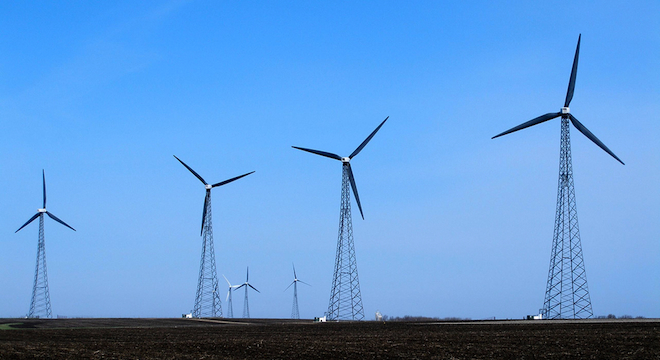The U.S. Energy Department on Tuesday released a report on the state of wind energy installations throughout the country during the year 2011. The report paints an encouraging picture of a recovering wind sector from the year 2010 — when the effects of the recession were being felt in full — but it still shows the U.S. lagging behind China when it comes to new wind energy generation capacity.
In total, the U.S. added 6.8 gigawatts of wind power production capacity from 562 turbines in 2011, enough to power 1.7 million homes. That was a growth rate of 16 percent overall and 31 percent over 2010.
The U.S. now has 47 gigawatts of wind energy generation capacity, enough to power 11.8 million homes, or 3.3 percent of the nation’s electricity demands.
California led the nation in new wind power installations with 921 megawatts added, but the Midwest also saw strong development — with Illinois, Iowa and Minnesota all installing between 500 and 700 megawatts each. Iowa is second now to Texas in terms of overall wind generation capacity.

Wind turbines are also getting larger blades and taller, and thus able to generate more electricity, according to the report.

More promisingly, that amount of new wind energy generation capacity represented 32 percent, or nearly a third of all new electrical generation capacity installed in the U.S. for the year (second only to natural gas, at 49 percent, and well ahead of coal at 12 percent). A total of $14 billion was invested in wind energy projects over the period.
Also, U.S. wind power installations for 2011 accounted for 16 percent of all wind energy generation capacity installed around the world in 2011.
But as has been the case since 2009, the U.S. is still second to China when it comes to new installations and overall wind energy generation capacity.
“China now dominates global wind power rankings, with an approximate 42 percent share of the global market for new wind power additions in 2011,” the Energy Department’s new report notes.
That’s disappointing news for the U.S. wind energy sector given that America led the globe in new wind energy installations from 2005 through 2008.
Further, “four of the top ten, and seven of the top 15, leading global suppliers of wind turbines in 2011 hail from China,” and “with the Chinese market beginning to show signs of cooling…Chinese (and South Korean) manufacturers have begun to look abroad and penetrate the international wind turbine market, including with limited sales into Europe and the United States.”
Still, the Energy Department sought to play up the report’s positives ahead of President Obama’s scheduled trip across Iowa on Tuesday, given that Iowa employs about 7,000 of the country’s total 37,000-some direct employees in the wind energy sector (the Energy Department says there are 75,000 full time jobs in the U.S. wind energy sector).
“Smart investments are paying dividends across the U.S. wind industry,” wrote David Danielson, assistant secretary for energy efficiency and renewables at the Energy Department, in an official blog post. “From Des Moines to Amarillo to Denver, the American clean energy economy is hard at work – creating jobs right now and ensuring our global competitiveness in the clean energy technologies of the future. We can’t afford to break this momentum.”
Specifically, the Energy Department and the Obama Administration support the extension of the production tax credit (PTC), a federal tax reimbursement of 2.2 cents per kilowatt-hour of wind energy produced, which expires at the end of 2012 unless re-approved by Congress.
Republican Presidential candidate Mitt Romney is against the extension of the production tax credit, with his campaign asserting that wind energy should be left to free market demand to spur development.
Yet as the report makes clear, the years when the tax credit lapsed (Congress didn’t re-authorize it) were detrimental to the growth of the U.S. wind energy sector:
“The historical importance of the PTC to the U.S. wind power industry is illustrated by the pronounced lulls in wind power capacity additions in the three years (2000, 2002, and 2004) in which the PTC lapsed, as well as the increased development activity often seen during the year in which the PTC is otherwise scheduled to expire.”
There’s another wrinkle to the matter of the tax credit, as the report points out: “The Recovery Act also enabled wind power projects to elect a 30% cash grant from the Treasury in lieu of federal tax credits… More than 60% of the new wind capacity installed in 2011 elected the cash grant.” But those projects need to have been started in 2011 and must be up and running by the end of this year to qualify.
No surprise that with both of these provisions (and a third tax credit, the investment tax credit) due to expire in 2012, “the wind energy sector is currently experiencing serious federal policy uncertainty, and therefore rushing to complete projects by the end of the year.”
But the report does see some positives, including the fact that while no U.S. wind farms have been installed offshore, there’s a federal effort underway this summer to spur development.






